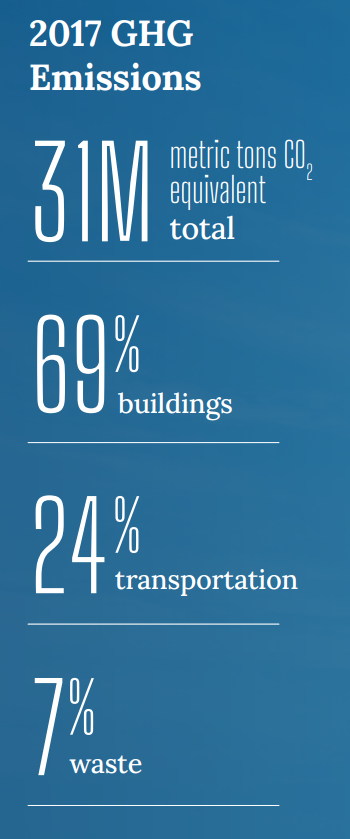Electrify Chicago
An independent tool for viewing City of Chicago building data
According to the
2022 Chicago Climate Action Plan,
69% of Chicago's emissions come from buildings, making
building emissions our biggest challenge and our biggest opportunity as a city
to tackle climate change. At Electrify Chicago, we showcase building performance using
publicly available data supplemented by community-submitted photographs and building
owners.
Start by looking at Chicago's buildings with the highest greenhouse gas intensity i.e. emissions per square foot. Large, efficient, buildings can perform much better than very inefficient small buildings on this metric.
New Article
📰 $30 Million In Missed Fines
The City Of Chicago failed to collect $30 million in potential fines from the building benchmarking ordinance, reducing transparency and accountability.
Legislative update! 🎉
As of late January 2024, legislation is being introduced to require new use more efficient forms of water and space heating, via the Clean And Affordable Buildings Ordinance (CABO), which will reduce the number of highly polluting and inefficient buildings that end up on this site.
If you're in Chicago,
write to your alderman to support the CABO!
Chicago Buildings by Greenhouse Gas Intensity
Note: Data includes large Chicago buildings with data from 2022, unless explicitly stated otherwise.
Note: This data only includes buildings whose emissions are reported
under the
Chicago Energy Benchmarking Ordinance. According to the City “As of 2016,
this list includes all commercial, institutional, and residential buildings larger than
50,000 square feet.” This dataset is also then filtered to only buildings with
reported emissions > 1,000 metric tons CO2 equivalent.
The latest year of data is from 2022, but we update the site regularly when new data is available, and some buildings may have failed to report that year, and only have older data available.
| Property Name / address | Primary Property Type |
Greenhouse Gas Intensity (kg CO2 eq./sqft) |
Total Greenhouse Emissions (metric tons CO2 eq.) |
|---|---|---|---|
|
1245 S WOOD ST
1245 S WOOD ST
| Senior Living Community | 7.4 kg/sqft
Highest 33%
| 618 tons
Lowest 35%
|
|
5858 Shore Manor Condominium Homeowners Association
🕰️
5858 N. Sheridan Road
| Multifamily Housing | 7.4 kg/sqft | 543 tons |
|
1301 1307 N ASTOR ST
1301 1307 N ASTOR ST
| Multifamily Housing | 7.4 kg/sqft
Highest 33%
| 417 tons
Lowest 18%
|
|
1418 N Lake Shore Dr Condo Association
1418 N LAKE SHORE DR
| Multifamily Housing | 7.4 kg/sqft
Highest 33%
| 711 tons
Lowest 41%
|
|
1240 N LAKE SHORE DR
1240 N LAKE SHORE DR
| Multifamily Housing | 7.4 kg/sqft
Highest 33%
| 1,115 tons
Highest 41%
|
|
1034 1038 N DEARBORN ST
1034 1038 N DEARBORN ST
| Multifamily Housing | 7.4 kg/sqft
Highest 33%
| 535 tons
Lowest 29%
|
|
833 W BUENA AVE
833 W BUENA AVE
| Multifamily Housing | 7.4 kg/sqft
Highest 33%
| 1,372 tons
Highest 35%
|
|
200 W Jackson Boulevard Bldg
200 W Jackson Blvd
| Office | 7.4 kg/sqft
Highest 33%
| 3,943 tons
Highest 9%
|
|
111 E Wacker Dr
111 E Wacker Dr
| Office | 7.4 kg/sqft
Highest 33%
| 8,494 tons
Highest 3%
|
|
DePaul Center
(DePaul)
1 E Jackson Blvd
| College/University | 7.4 kg/sqft
Highest 33%
| 5,223 tons
Highest 6%
|
|
4554 S DREXEL BLVD
4554 S DREXEL BLVD
| Multifamily Housing | 7.4 kg/sqft
Highest 33%
| 659 tons
Lowest 38%
|
|
Q11970
2401 W Grace St
| Office | 7.3 kg/sqft
Highest 34%
| 675 tons
Lowest 39%
|
|
John C Burroughs Elementary School
3542 S Washtenaw Avenue
| K-12 School | 7.3 kg/sqft
Highest 34%
| 387 tons
Lowest 16%
|
|
176 N Racine Avenue
176 N Racine Avenue
| Office | 7.3 kg/sqft
Highest 34%
| 1,235 tons
Highest 38%
|
|
Prajakta Meharunkar
1515 W Webster Avenue
| Office | 7.3 kg/sqft
Highest 34%
| 1,576 tons
Highest 30%
|
Data Source:
Chicago Energy Benchmarking Data
